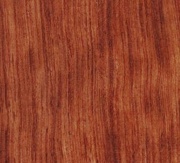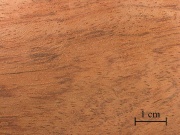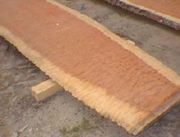Difference between revisions of "Bubinga"
Jump to navigation
Jump to search
| Line 10: | Line 10: | ||
==Physical and Chemical Properties== | ==Physical and Chemical Properties== | ||
[[File:image 1-african rosewood.jpg|thumb|Cut piece of African rosewood]] | [[File:image 1-african rosewood.jpg|thumb|Cut piece of African rosewood]] | ||
| − | Color: purplish or reddish brown with stripes or mottling. Rings: distinct. Pores: diffuse, fine. Grain: faint. Rays: distinct. Hard, very heavy. | + | * Color: purplish or reddish brown with stripes or mottling. |
| + | * Rings: distinct. | ||
| + | * Pores: diffuse, fine. | ||
| + | * Grain: faint. | ||
| + | * Rays: distinct. | ||
| + | * Hard, very heavy. | ||
{| class="wikitable" | {| class="wikitable" | ||
Revision as of 14:40, 10 May 2022
Description
A hard striped wood obtained from Guibourtia tessmannii and Guibourtia demeusei trees found in western Africa. Bubinga, or African rosewood, has either a light red, brown or violet background with evenly spaced pink or purple stripes. It has a medium texture and polishes to a high gloss. Bubinga is a decorative wood that is used for furniture, cabinets, veneer, pianos, and decorative items (handles, brushes, boxes, etc.).
Synonyms and Related Terms
Guibourtia tessmannii; Guibourtia demeusei; benge; African rosewood; eban; kevazingo (Gabon); amazakoue (Ivory Coast); essingang, nomele, ovoga, ian, omebaba, ogbonele, owong, nsu, simingan (Cameroons);
Physical and Chemical Properties
- Color: purplish or reddish brown with stripes or mottling.
- Rings: distinct.
- Pores: diffuse, fine.
- Grain: faint.
- Rays: distinct.
- Hard, very heavy.
| Density | 50-57 ppcf |
|---|---|
| Molecular Weight | specific gravity = 0.91 |
Resources and Citations
- Ralph Mayer, A Dictionary of Art Terms and Techniques, Harper and Row Publishers, New York, 1969 (also 1945 printing)
- Kribs, Commercial Foreign woods on the American market
- H.L.Edlin, What Wood is That?, Viking Press, New York, 1969


